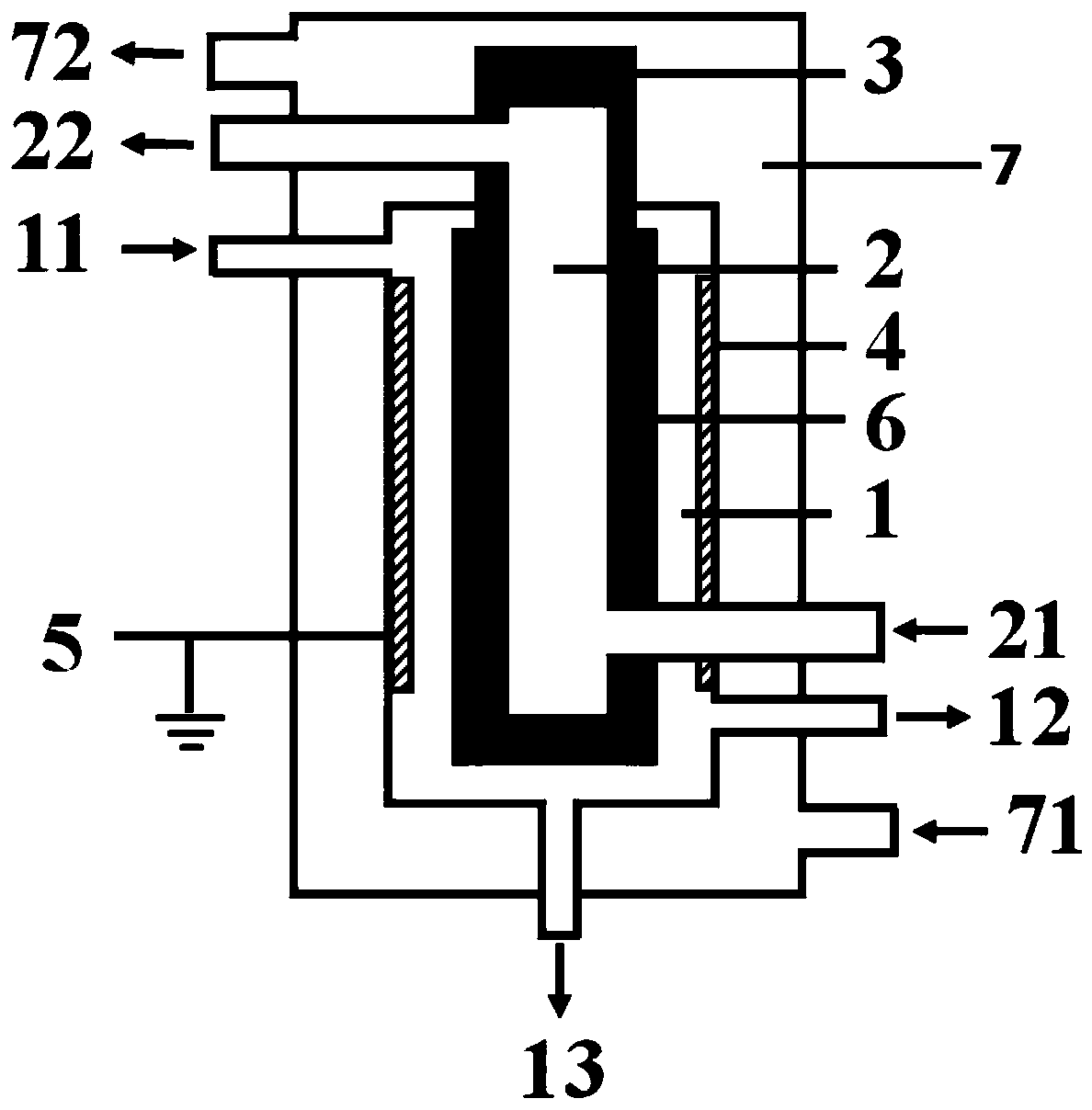A low temperature plasma device and method of decomposing hydrogen sulfide
A low-temperature plasma and hydrogen sulfide technology, applied in the field of plasma chemistry, can solve the problems of low conversion rate of hydrogen sulfide and high energy consumption for decomposition
- Summary
- Abstract
- Description
- Claims
- Application Information
AI Technical Summary
Problems solved by technology
Method used
Image
Examples
Embodiment 1
[0113] use figure 1 The plasma reaction device shown performs hydrogen sulfide decomposition reaction. The specific structure and structural parameters of the plasma reaction device are as follows:
[0114] The reaction device includes:
[0115] A first cavity, the first cavity is respectively provided with a first inlet, a gas product outlet, and a liquid product outlet;
[0116] A second cavity, the second cavity is nested inside the first cavity, and a second inlet and a second outlet are respectively provided on the second cavity; the side walls of the second cavity are both It is formed by internal electrodes, the material for forming the internal electrodes is stainless steel, and the internal electrodes are connected to a high-voltage power supply;
[0117] A third cavity, the third cavity is nested outside the first cavity, and a third inlet and a third outlet are respectively provided on the third cavity; forming the third cavity Material is stainless steel;
[0118] The out...
Embodiment 2
[0145] In this embodiment, a plasma reaction device similar to that in embodiment 1 is used to carry out the decomposition reaction of hydrogen sulfide. The difference is that in this embodiment:
[0146] All side walls of the first cavity are formed by external electrodes, the material for forming the external electrodes is stainless steel metal foil, the external electrodes are connected to a high-voltage power supply, and the internal electrodes are grounded;
[0147] L 2 And the thickness of the blocking medium D 1 The ratio of is 15:1; and H 1 : L 3 =1:120.
[0148] In this embodiment, H is introduced into the first cavity of the plasma reaction device from the first inlet 2 S / H 2 Mixed gas, where H 2 The volume fraction of S is 80%, the flow rate of the mixed gas is controlled so that the average residence time of the gas in the discharge zone is 18.7s, and the reaction pressure in the first cavity of the reactor is maintained at 0.04 MPa in this embodiment. H 2 S / H 2 After the...
Embodiment 3
[0152] In this embodiment, a plasma reaction device similar to that in embodiment 1 is used to carry out the decomposition reaction of hydrogen sulfide. The difference is that in this embodiment:
[0153] The outer electrode is arranged on the inner side wall of the first cavity, the material for forming the outer electrode is copper foil, the outer electrode is grounded, and the inner electrode is connected to a high-voltage power supply;
[0154] The barrier medium is arranged on the outer surface of the part where the inner electrode extends into the first cavity, and the upper edge of the barrier medium is higher than the upper edge of the solid ground electrode. The material of the barrier medium is ceramic ;
[0155] L 2 And the thickness of the blocking medium D 1 The ratio is 0.7:1; and H 1 : L 2 =1:250.
[0156] In this embodiment, H is introduced into the first cavity of the plasma reaction device from the first inlet 2 S / Ar mixture, where H 2 The volume fraction of S is 25%...
PUM
 Login to View More
Login to View More Abstract
Description
Claims
Application Information
 Login to View More
Login to View More - R&D
- Intellectual Property
- Life Sciences
- Materials
- Tech Scout
- Unparalleled Data Quality
- Higher Quality Content
- 60% Fewer Hallucinations
Browse by: Latest US Patents, China's latest patents, Technical Efficacy Thesaurus, Application Domain, Technology Topic, Popular Technical Reports.
© 2025 PatSnap. All rights reserved.Legal|Privacy policy|Modern Slavery Act Transparency Statement|Sitemap|About US| Contact US: help@patsnap.com

